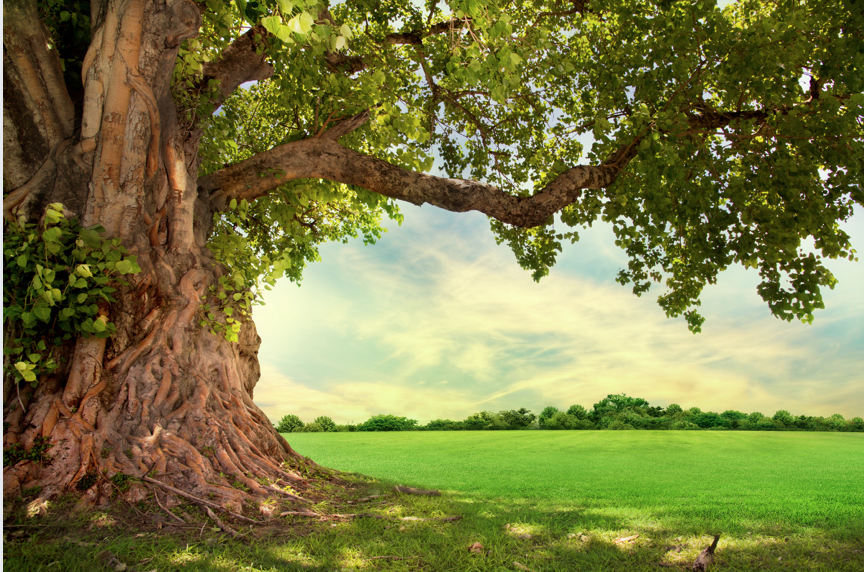It is strange to talk about the New Year for Trees, Tu B’shvat the traditional celebration of early Spring, during a snowstorm.
The holiday’s original purpose was to demarcate one year’s crop from the next for tithing purposes. Effectively, a tax year. In Israel, where the holiday originated, this also works a bit like Groundhog day (not the movie–the holiday) a reminder that Spring is just around the corner…. It may not feel like it, but Spring is on its way.
Trees represent much more than an aspect of nature. Trees make for easily accessible symbolism. And they have across religions and cultures throughout human history. Finding symbolism in trees is a low hanging fruit, pardon the pun. The rationale for the holiday has shifted over the centuries, and it can be as relevant today as it was when the Temple stood.
The tithing requirement in Temple times included wheat, barley, grapes, figs, pomegranates, olives and dates. And, we’ve learned that Tu B’shvat marks the beginning of the tax year. But, if we look at the seven species, only a few are fruit from trees.
Marking the agricultural year with the tree has a purpose. Trees are central and sacred in Judaism. The Torah is referred to as the Tree of Life, trees are to be protected in times of war (Deuteronomy 20:19-20), and the first thing Israelites were commanded to do as they entered the land after 40 years in the wilderness, was to plant fruit trees (Leviticus 19:23). It is also practical to mark the beginning of the agricultural year with trees. While crops in the field are most certainly still dormant, the awakening process for trees, the moving of sap does start early. Thereby, giving an excuse for placing the start of the tax year at a time when it is clear what was last year’s harvest and what will be this year’s. Judaism is nothing if not practical.
But, this holiday was maintained even after the times of the Temple. Honoring nature and trees makes too much sense to leave it by the wayside.
The Kabbalists developed the Tu B’shvat seder (ritual meal) to honor the trees, and to glean (more puns!) meaning from the various fruits. The four types of fruits of the Tu B’shvat seder are:
- Inedible outer shell (walnuts, bananas, peanuts, etc) — these represent a shield from external danger.
- Edible outer flesh and inedible core (cherries, mangoes, avocados) — these represent reinforcement, protection of the heart.
- No shell, can be eaten in their entirety (strawberries, blueberries etc.) — these represent pure emotion (love), no walls or barriers.
- Non-edible fruit/no fruit — these represent the spirit, independent and vital, a symbol of life
Honoring trees has teaching potential, too. The Torah is referred to as the Tree of Life. And we are advised to hold fast to it, not for the sake of the Torah, but for our own, as it will lead to happiness. Why? How? Ethical behavior, sure. But, also the social and legal organization of the Torah lays the foundation for a just society.
And then there’s the lesson that came to me just recently. One of the positive things that this year of COVID isolation has brought to me is how much I love to walk. On one such walk I saw a beautiful, huge, old tree. This one wasn’t in the forest, but near a residential neighborhood. It was majestic. I looked at it, and was moved to hug it. My arms didn’t come close to encircling it, but that didn’t stop me. Yes, I literally hugged a tree. I shed tears of joy. A few weeks later, after one of our summer storms, it came crashing down. And again, I was moved to tears, of sadness.
One tree, and fairly acute emotions. I read about the deforestation of the Amazon, and I am saddened and angered. I read about the destruction of wildlife habitats and I am outraged. I read about the effects of pollution and I am frustrated. But, none of these move me like the one tree that brought me joy and brought me sadness.
Why? There’s the apocryphal quote: “One death is a tragedy, a million deaths a statistic.” That’s human nature. It is also callous and unfeeling. But, I ask of you, and of myself–to flip that on its head. Maybe we should remember to look at the statistics and find a way to make the data personal. It is scary to do this. The numbers on environmental damage are appalling. I don’t ask that we walk around in a constant state of fear and anger. That’s not a really good idea. But, occasionally we should try to remember a time when we were emotionally invested in a tree, and extend that to the bigger picture.
This works for trees, and for people. This is an exercise in empathy and compassion. Statistics help outline a picture. Individuals make up the colors. We should try to see both.

